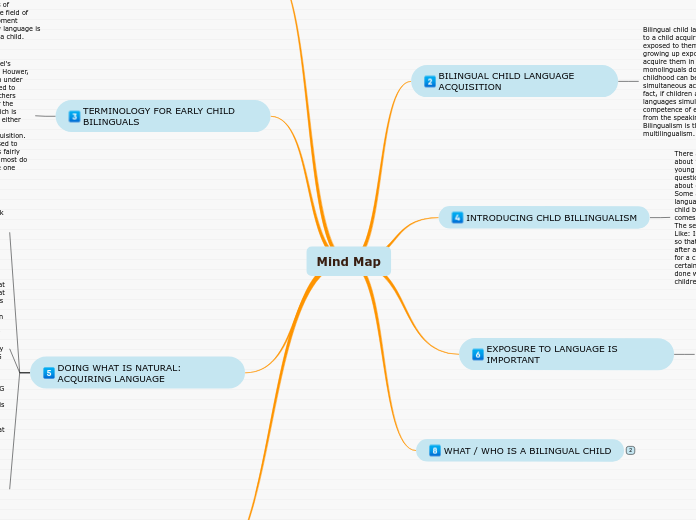
Bilingual child language acquisition generally refers to a child acquiring two or more languages when exposed to them as a very young child. Children growing up exposed to two or more languages acquire them in practically the same way as monolinguals do. Bilingual Acquisition during childhood can be regarded as an instance of simultaneous acquisition of two ‘first’ languages. In fact, if children are exposed to more than two languages simultaneously, they are able to acquire competence of each that does not substantially differ from the speaking ability of monolinguals. Bilingualism is therefore a special case of multilingualism.
There are many questions that most people have about what is involved in he process when very young children speak two or more languages. These questions revolving around two topics the first being about concerns in differentiating the two languages. Some are: Is it possible for the child to speak both languages well but keep them separate? When these child bilinguals speak, do they just speak whatever, comes out first, or do they mix languages, or what? The second curiosity concerns the age of acquisition. Like: Is there a cutoff point in languages acquisition so that second language learning is more difficult after a certain age? i.e. what kind of support is there for a critical age hypothesis, the proposal that after a certain age, second language learning cannot be done with the same ease as it can for very young children.
Children need actual exposure to a language in use by others to develop a linguistic system (a language). How important the extent and quality of exposure remains a unanswered, but undoubtedly exposure is vital. Evidence does show that whatever language or languages children are exposed to will be acquired. Acquisition is practically complete by the age of three or four for normal children; this depends somewhat on the convolution of the grammatical elements in the language. Additionally, all children monolinguals or bilinguals acquire language effortlessly meaning they do so without overt instructions.
Acquisition as a technical term in linguistics means the natural imbibing of language in its cultural setting the language acquisition faculty is a typically human capacity, unique to human being.
In spite of the fact that language is a highly complex and structured system comprising of several systems, children acquire language fairly quick and with astonishing ease. Linguists and Psychologists became equally interested in this area of language acquisition, and during the 1950’s the discipline psycholinguistics emerged out of their collaborative work. The study of “language acquisition” is the most important area and main focus of psycholinguistics. It forms a separate field of psycholinguistics known as “Development Psycholinguistics” which studies how language is acquired during the development of a child.
Researchers of child bilingualism use different
terminologies. When children hear two languages from birth, according to Meisel's theory developed in 1989, he called this bilingual first language acquisition. De Houwer, (2005) also used this terms stating that she applies it to her studies of children under the age of six who were exposed to two languages from birth and who continued to hear these languages fairly regularly up until the time of a study. Other researchers studying early bilingualism use the term bilingual child language acquisition for the object of their study to distinguish it from acquisition of only one language, which is called child language acquisition. All these acquisition researchers avoid calling either language the L1 because, both languages are the child’s first language. Many researchers set very stringent time limits of what should count as bilingual acquisition. De Houwer, (1990) proposed that bilingual acquisition means the child is exposed to language B no later than a week after exposure to language A, and exposure is fairly regular on a daily basis. Even if all researchers don't follow this sharp division, most do refer to acquisition before age three as simultaneous acquisition. And of course one researcher’s definition of a bilingual may not be same as that of another.
Many who come from largely monolingual societies look upon very young children who speak two or more languages as linguistic marvels. We often think such children must be super intelligent to “master” speaking two languages before they can ride a bicycle or tie their shoes. But these children are not bilingual geniuses; they are simply doing what children of normal intelligence can do. That is, they acquire the language varieties to which they are exposed.
All normal children come with a genetic program that predisposes them to acquire human languages. What exactly is in this program remains controversial. It is part of the general “nature–nurture” debate as to how much language development is dependent upon cognitive pre-programming specifically designed for building a language. Those who favor “nature” refer to the role of Universal Grammar, (Chomsky 1965;1981) part of an innate faculty that makes any type of language acquisition possible; the role of UG is to provide limits on which structures are possible in human languages and which are not. One of the most prominent researchers on UG, in second language acquisition, Lydia White, (2003) defines UG in this way: “UG constitutes the child’s initial state [so], the knowledge that the child is equipped with is advance of input”
The contrasting view (the “nurture view”) claims that language development is the product of general learning mechanisms. The idea says that humans with exposure to a language in use can use this general mechanism to develop language through analogical thinking and other forms of associations. No matter which side one takes, evidence supports the assumption that some form of innate faculty accompanies language acquisition. This evidence is the finding that children all over the world go through similar stages when they acquire the grammatical systems of their specific languages. If we didn’t have an innate faculty that forgoes language acquisition, it would be hard to explain the similarities that are found around the world through the steps in acquiring different languages.